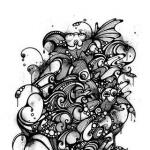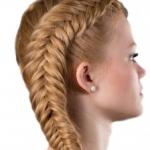How to give a back massage to a small child. Massage for a child: it turns out that it’s not always possible
The baby that is born needs special careful care. Young parents who are concerned about their baby’s development will have to learn many things. One of these useful procedures is massage for newborns.
Regular massage for newborns at home is a vital necessity.
Sessions are needed for:
- Getting rid of excessive muscle tone.
- Treatment and prevention of various diseases.
- Massage is one of the forms of learning about the world around us: the mother’s touch evokes positive emotions and joy in the baby.
- Relaxation before bed.
- Relieve pain syndrome.
- Improves blood circulation.
- Improving the functioning of the gastrointestinal tract.
- General strengthening of the body.
- Enhance immunity.
How to massage a child?

Remember that massage for newborn babies has its own distinctive features, due to the fact that the child’s body is very fragile and cannot withstand too intense stress. In order not to harm your baby, follow the basic rules for this procedure:

The technique or features of the massage do not depend on the gender of the child. A newborn girl needs the procedure to the same extent as a boy.
Basic techniques:

neck infant massage very carefully, kneading and stroking only the muscles - from the shoulders to the hairline. There should be no impact on the spine! Perform with both one and two hands, without weighting. Movements tend to move towards the center. In addition, babies are given turns and tilts of their heads. This massage is highly recommended for torticollis in infants, and is one of the ways to get rid of this fairly common ailment.
Massage for colic
For indigestion, colic, bloating and constipation, children are also recommended to have a massage. This will ease their condition and relieve discomfort and will establish natural processes. This procedure also helps with umbilical hernia or a predisposition to its occurrence.
- The room should be warm, about 25-26 degrees. Turn on the heater if necessary.
- Place the baby on his tummy and carefully massage the sacrum area with light movements.
- Then pay attention to the baby's tummy. It is massaged clockwise with soft circular movements. Occasionally apply light pressure with the entire surface of your palm.
- The main technique is stroking of varying intensity. Alternate them. Possible tingling around the umbilical area.
- Do not use acupressure or too much pressure under any circumstances!
After such a massage, your baby may want to go to the toilet, so be prepared for this, prepare everything you need in advance.

The following techniques are used to prevent hernia:
- Leg raises while lying on your back. Raise one leg at a time or both at a time. Pull your toes towards you, to the sides. This will strengthen your abdominal muscles.
- Help your baby sit up on his own.
- Make torso turns together.
- To treat this disease, pinpoint pressure around the navel is sometimes used. However, such a technique is usually prescribed by a doctor: it is better not to use such techniques without his consent.
Massage for bronchitis
If a little man is struck by this illness, then in addition to drug treatment prescribed by your pediatrician, you can also use massage. It will alleviate the child’s condition and speed up recovery. Can be done on the 3-5th day of illness. Cannot be done with elevated temperature bodies!

Due to her age, the baby cannot cough up mucus on her own, and the correct actions of a massage therapist will help remove phlegm from the lungs.
The advantage of this type of procedure is that the mother can conduct sessions on her own at home. This does not require special skills or special equipment.
Massage technique:

After the treatment procedure, be sure to wrap up the child, cover him with a warm blanket and let him lie down.
Remember that when treating bronchitis, an integrated approach is important, so use all treatment methods recommended by your doctor. If your child experiences complications and begins to feel worse, be sure to contact specialized institution for medical help.

Contraindications to massage
Like any procedure, massage has a number of contraindications.
Parents know that different stages growth and development of the baby, one or another type of baby massage is very beneficial for the child’s health. And sometimes it’s absolutely necessary! That is why experienced children's massage therapists have always been and will remain “worth their weight in gold.” But few parents know that in the vast majority of cases they can massage their children themselves. We will tell you what these cases are and which baby massage techniques are suitable for them.
Every caring and patient mother is capable of doing things for her child on her own. baby massage. And not only humorous. But also restorative and even healing! The main thing is that this procedure brings everyone who participates in it not only benefit, but also pleasure!
Massage for children: when and in what cases is it necessary?
There are countless types of massage - it can be therapeutic, health-improving, strengthening, cosmetic, anti-cellulite, warming, relaxing, erotic, preventive, and dozens of other “faces”. It is clear that only a few of this number have anything to do with children.
Children begin to have a baby massage almost from birth (to be more precise, immediately after). For obvious reasons, we will not touch upon specific types of children’s massage in this article, which are used for children who are seriously ill with neurological diseases, or who have serious defects in the musculoskeletal system, etc.
We will talk about more or less healthy children, who, nevertheless, often also need a certain therapeutic children's massage. Cases where parents not only can massage their child themselves, but should also include:
- General strengthening children's massage and gymnastics for children of the first year of life;
- “Analgesic” baby massage for infants;
- Massage of the lacrimal canaliculus for congenital blockage and signs of conjunctivitis;
- Baby massage, relieving and...
In addition, a light general massage for a child up to one year old before bathing in a large bath helps the baby sleep soundly and peacefully throughout the night.

Finally, baby massage is an excellent way to bond with your baby!
For a child in his first year of life, constant communication (especially with his mother) is extremely important, not only at the visual level, but also at the level of contact. Simply put, the baby needs the touch of his mother’s hands. Therefore, a loving and caring mother who gives her baby a baby massage every day not only helps the baby get rid of colic or tones his muscles, but also satisfies the baby’s need for communication!
General strengthening baby massage for a child up to one year old
During the first year of life, massage for a child gradually changes - some exercises replace others. At its core, baby massage for infants performs several important functions at once:
- increases the child’s blood circulation;
- strengthens muscles;
- being part of the child's hardening system, children's massage increases the protective properties of the baby's immunity;
- allows the mother to communicate with the baby, satisfying his natural need for tactile contact;
Visiting nurses will probably tell you how to massage a very tiny child - a newborn and a baby up to 3 months old - in the first days after discharge from the hospital. We will give a visual example of a later baby massage - for a child 3-6 months old.
Massage for children 3-6 months: video for training
* children's m assage conducts nurse in massage of the highest category Tatyana Morozova (GBUZ DGP No. 99 of the Moscow Department of Health)
Rules for performing restorative massage for children
There are several simple ones, but important rules, which you must learn before giving a massage to your child:
- 1 You can use only 3 techniques during a massage:
Stroking (in other words - light rubbing);
- pressure;
- vibration.
How to correctly determine the force of pressure during a baby massage? To do this, parents will have to partly “visit” the child’s place: with two fingers, carefully press on their eyeball (the eyes, of course, should be closed). As soon as you feel the slightest painful sensations and discomfort, it is precisely this pressure force that you should consider to be the maximum when massaging a child.
- 2 You can’t do a baby massage “dry” - you need to lubricate your hands with a special massage product. And remember: any product used to massage children under 3 years of age must be “edible.” That is, you should be completely calm if your baby puts a fist with traces of massage oil in his mouth, and not worry that a terrible allergy attack or poisoning awaits you ahead. In addition, it is highly desirable that the massage product has no odor.
- 3 Best time for a general strengthening children's massage - just before evening bathing (if we are talking about babies under 2 years old). That is, the sequence should be as follows: massage, gymnastics, bathing, feeding, night sleep).
- 4 And finally: as a rule, the time of one session of “home” mass is limited to 5-10 minutes.
All participants in the massage - both the child and the mother - should enjoy the process. The time of the procedure itself directly depends on this. As soon as one person gets tired, the massage should end.
When should you not give a restorative massage to a small child?
Baby massage cannot be performed in the following cases:
- if the child is sick (is in acute period infectious disease);
- when the baby is hungry;
- if the child clearly does not like what is happening to him (the child screams, cries, purses his lips, waves his arms, tries to roll over, bends, etc.). In this case, you can experiment a little with the timing of the massage, the amount of pressure on the skin, the massage agent, etc. Perhaps there is simply some minor irritant, the elimination of which will radically change your baby’s mood during the massage. But if no changes affect the result, the massage should be stopped once and for all.
- when the child is sleeping (if you massage a sleeping child, this will not bring him any strong, healthy sleep, nor the effective effects of massage).
How can you understand that a baby enjoys a massage and brings not only benefits, but also pleasure? In this case, there are obvious “signs”, such as:
- the baby does not fall asleep and is not nervous;
- the child smiles;
- the baby's mouth is slightly open;
- he actively walks and looks into the face of those who touch him;
“Analgesic” baby massage for colic in infants
We have already mentioned more than once that a light massage of the baby’s tummy effectively helps with colic - the tactile effect reduces pain, soothes and improves digestion. However, a positive effect is possible only with correct and patient influence. How exactly to massage a child with colic? Let's explain:
- 1 Lay the baby on his back on a soft, pleasant-to-touch surface (fluffy blanket or blanket, etc.);
- 2 Place the heel of your right palm against the baby's pubic bone (you don't have to remove the diaper to do this);
- 3 Using the fingers of your palm, make fan-shaped movements along the baby’s tummy strictly clockwise.
- 4 This baby massage can last as long as desired, but usually after 5-7 minutes the child feels relief - the colic stops.
Children's massage of the lacrimal canaliculus for signs of conjunctivitis
Parents can practice this type of baby massage in cases where the baby has a baby. Often the reason for this is congenital blockage of the nasolacrimal canaliculus, due to which tear fluid cannot flow unhindered into the nasal cavity, which sometimes causes the “sour eye” effect.
In 90% of cases, congenital blockage of the lacrimal duct disappears on its own by the age of 1 year. However, a simple massage, which any mother and any father can do, can significantly speed up the process of normalizing the outflow of tear fluid.
How exactly to do this baby massage? Apply carefully middle finger co inner corner the child's eyes - under the pad you should feel the presence of a lacrimal sac (as if a soft grain of rice is rolling under the skin). As soon as you feel it, move your finger 3-4 mm higher and make light, slightly pressing movements from top to bottom (and only in that direction!). The frequency of massage movements in this case is about 10-12 times during each feeding of the baby.
The ideal option is when the massage technique for blockage of the lacrimal canaliculus is taught to you personally by an ophthalmologist or pediatrician during a consultation.
Massage for children, relieving cough due to bronchitis and obstructive bronchitis
In children, mucus accumulates in the bronchi, which partially dries out, literally “sticking” to the walls of the respiratory tract. If the baby is not able to cough it up on his own, you can alleviate his situation with the help of a special baby massage:
- 1 Place your baby on your lap (face down) so that his butt is slightly higher than his head. Such an inclination towards the floor is necessary in order to use the force of gravity - it will also contribute to the removal of phlegm from the bronchi.
- 2 Then, using your fingertips, gently but firmly tap him on the back in the area of the shoulder blades. The movements of your fingers should be slightly “raking” - as if you are trying to dig a small hole in the ground with your hand. Perform these “raking movements” strictly in one direction - “row” from the lower back to the head.
- 3 Then suddenly sit the child on your lap and ask him to cough.
- 4 These manipulations can be repeated 2-3 times in a row.
Please note that under no circumstances should any baby massage be performed while the baby is heat, fever It is also not recommended for those children who cannot yet cough “on command” (that is, children under 2 years old).
Massage for bronchitis: video
So, as you can see, there are quite a few situations and some serious ones. medical problems, which parents can completely cope with on their own, if they know how to apply one or another baby massage technique in relation to their child in time.
Baby massage has a number of benefits. By giving your baby a massage yourself, you strengthen your bond with him. Also, baby massage improves the child's sleep, helps get rid of colic, develops motor skills, strengthens the child's immunity and even improves it intellectual development. So it’s simply irreplaceable! Of course, you are interested in how to massage a child.
We'll look at the techniques used to massage different parts of your baby's body. Also at the end of the article you will see how to massage a child (video).
Tips on how to massage a child
- Before the massage, be sure to make sure that your child is in good mood.
- You should sit on the floor or any flat surface with your legs in a “diamond shape” (knees out, feet close) to comfortably place your baby between them.
- Place a towel or blanket over your legs and knees.
- Remove your baby's clothes and diapers and place her on a blanket with her head resting on her feet.
- Start with gentle stroking from head to toe and see if your baby likes it and then continue massaging each part of the body, or stop if baby doesn't feel comfortable and try massaging your baby another day.
1. Children's foot massage
It is better to start a baby massage with the feet, as they are less tender than other parts of the body.
- Lift one of your legs by the ankle.
- Gently stroke from hip to foot and back in each direction several times.
- Grab your leg from the hip with both hands and slowly stroke from hip to foot, as if you were twisting a towel.
- Using your thumb, make the child from heel to toe. Then use your palm to stroke the bottom and top of your baby's foot. Using your thumb, slowly make the baby in a circular motion along the foot of each leg.
- Finally, lightly squeeze and apply force over each toe.
2. Baby hand massage
After the legs, it's time to move on to the children's.
- Take your child's hand by the wrist and relax his arm by lightly tapping him on the shoulder.
- With one hand, lift the child's hand by the wrist, and with the other hand, clasp the child's shoulder.
- Gently stroke from top to bottom using rotating movements.
- Massage your palm with circular movements of your thumbs.
- Stroke from wrist to fingertips, then lightly pinch each finger.
3. Baby breast massage
Baby breast massage can be fun - your baby is sure to love it!
- Place both hands in a prayer position on your baby's chest and gently stroke the chest from the middle to the shoulders.
- Starting at the top of your chest, trace a heart shape with your hands, leading them to your shoulders and then down and bringing them together again. Repeat these steps several times.
4. Baby belly massage
Children's abdominal massage should be carried out using gentle strokes, remembering that the child's stomach is a very delicate and sensitive part of the body.
- It is necessary to massage with your fingertips in a clockwise direction, in a circular motion.
- Using light strokes, write “I Love U” on your belly. How to do this, see below.
- Write a long I from top to bottom on the child's left side.
- Then do an inverted L, stroking from the belly to the ribs from the right side to the left and then down.
- Now the inverted U - you need to stroke from the right side of the abdomen to the navel, and then lower it to the left side.
- Using patting movements with your fingers, walk around the navel clockwise.
- Squeeze your baby's knees and feet together and press them lightly against the tummy; this will help you avoid.
Every child is born with bent legs and arms, and his fists are securely clenched. The baby's motor activity is disordered and chaotic. This condition is quite normal, it is called “physiological tone” in pediatrics. To help the child quickly eliminate this tone, young parents should know how to massage a newborn.
Massage is daily procedure, complementing the full care of the newborn. It has a beneficial effect on the overall health and well-being of the baby, strengthens the emotional contact between the child and parents. Regular massage improves conditions for the normal development of the child.
Children's massage, depending on its focus, can be divided into the following types:
- medicinal;
- therapeutic and prophylactic;
- prophylactic.
How to massage a newborn correctly and how often depends on the diagnosis. Depending on this, specific massage methods are used to eliminate pathology. But good results can be seen simply from physical influences on skin the child and his muscles after just a few sessions.
Therapeutic and preventive massage is based on the impact on the entire area of the body with an obligatory emphasis on problem areas. As a result of the procedure, blood circulation processes are improved, the functioning of the heart and blood vessels is normalized, and pathological conditions of the muscular and skeletal systems are corrected.
This type of massage is used for problems with the digestive system, respiratory and genitourinary diseases. This type of massage is practiced exclusively by a specialist. Preventive massage promotes development motor activity baby.
With this procedure, the child learns faster:
- turn on your tummy;
- crawl;
- sit down;
- stand on your feet;
- walk.
Preventive massage is also useful for normalizing functional activity digestive tract, since it can eliminate intestinal colic in a newborn, which is a consequence of the physiological immaturity of the children's intestines.
Preventive massage performs the following tasks:
- normalizes blood circulation in tissues;
- improves the breathing process;
- stimulates metabolism;
- improves appetite;
- calms and improves sleep in restless children.
Therapeutic and therapeutic-and-prophylactic types of massage are recommended to the child by the doctor; such procedures are carried out within the walls of a medical institution or, if parents wish, at home. Preventive massage can be done for every child if there are no specific contraindications.
Benefits of massage
Human skin is penetrated by many receptors, which, against the background of an irritation reaction, send certain signals to the brain. In this way, the activity of the nervous and other systems of the body is stimulated, since the massage reaches the most receptors.
Massage improves blood circulation, beneficially affecting almost every organ in the child’s body. This is why preventive massage is strongly recommended by pediatricians from the first year of life.

In a newborn, vision and hearing are not fully formed, so they primarily perceive the surrounding space with the help of tactile sensations. It turns out that massage forms the primary emotional condition baby and the ability to perceive the world around you.
Pediatricians believe that massage is useful as a preventive measure against many diseases. Massage has a positive effect on the baby’s immune defense, protecting him from colds and viral infections.
In addition, massage normalizes the functioning of the digestive tract, eliminating such unpleasant conditions as constipation and colic in the child. It is impossible not to note the positive effect of this procedure on the musculoskeletal system.
Indications
When should you start giving massage to a newborn, in what cases is it prescribed?
We list these states:
- malnutrition;
- foot deformity (valgus, flatvalgus);
- tremor of any part of the body;
- residual reflex reactions;
- damage to the central nervous system;
- cerebral palsy;
- deformation chest;
- leg deformation (curvature);
- flat feet, club feet;
Also, massage for therapeutic and therapeutic-prophylactic purposes can be prescribed in the complex treatment of bronchial asthma, pneumonia, fractures and injuries of the limbs, etc.
Contraindications
You cannot carry out any massage procedures if:
- the child has an elevated body temperature;
- the skin is affected by a pustular infection or damaged;
- increased fragility of bone tissue;
- there are diseases of the blood and cardiovascular system;
- The baby is sick with ARVI.
If the child umbilical hernia, then massage should only be performed by a specialist, since the risk of pinching the hernia is high. Children with heart defects should be monitored by a cardiologist during massage. Massage should not be performed if the child has increased nervousness, as hypertonicity of the muscle tissue may increase.
At what age can you start massage and how often do you do it?
Many young mothers are interested in what age and what age can they massage their newborns? The first sessions of preventive massage can be started as early as two weeks of age. But until the child is at least 1.5 months old, massage should be carried out in the form of simple strokes. Later, when the child is 3 months old, other massage techniques are carefully introduced - rubbing, kneading and patting.
How often should you massage your newborn baby? It all depends on the presence of contraindications. If the child is healthy, then massage is prescribed to him in courses of 10 procedures once every 3 months. According to individual indications, the doctor can tighten the standard regimen, reducing the break between courses to 1 month.
Basic rules and features

Nuances to consider when giving a massage to a child:
- During the procedure, the room temperature should be 18-22°.
- The massage is carried out on a flat surface covered with a flannelette blanket, oilcloth and diaper. The surface of the table should be wide enough so that there are no restrictions when turning the child over.
- The procedure site must be equipped with everything necessary so as not to be distracted by missing items during the procedure.
- Manicure, long nails, jewelry on the hands - all this is incompatible with performing a massage on a newborn. Extra risk of injury small child to nothing.
- When can you massage a newborn? It is better to choose a time 1-2 hours after feeding, and also make sure that the baby is not tired and sleepy. Hunger and fatigue will only cause negative emotions in a child when performing a massage.
- During the procedure, you need to talk to the baby, while simultaneously developing his auditory and speech skills.
- The massage time can be gradually increased, as well as the techniques used can be made more complex.
- Movements should be measured and not cause discomfort to the child. 15 minutes is enough for one session.
Step-by-step instruction
How to massage a newborn? Let's consider the massage procedure step by step:
- Step one. We begin the movements with the child's hands. We massage our fingers separately, carefully unclench our fists for massage and stroke our palms. Then we move to the wrists and move up to the forearms, without touching the armpits.
- Step two. We pay attention to the legs. We massage the fingers and feet separately. Then we move with light movements upward towards the groin area. We do not touch the knees and the area under them.
- Step three. We stroke the tummy near the navel in a circular motion. We close our hands along the midline of the abdomen, make movements with our palms up and down, without touching the intimate organs of the child.
- Step four. We massage in the direction from the chest to the shoulders and back. Mammary glands don't touch.
- Step five. The child is placed on his stomach and we begin a neck massage. Movements are careful. If the child wants to lift or turn his head, we stop the massage.
- Step six. Using smooth movements from the lumbar region to the shoulders and from the spine to the sides, we massage the back. We don't touch the spine. The butt is stroked in the direction from the outer surface of the thighs to the tailbone.
- Step seven. We lay the baby on his left side and move our hand along the spine from the sacrum to the head. We make no more than 3 movements and repeat the same on the other side.
- Step eight. The child returns to the starting position, we begin massaging the head, excluding the fontanel area. We finish the massage with light stroking movements.
Even the strongest and healthiest newborn babies will benefit from massage. After all, during the procedure, the baby’s immunity and general health are not only strengthened, but attention is also paid to his communication and emotional skills. This means that such a child will not have a chance to fall behind physically or psycho-emotional development from peers.
Useful video about newborn massage
Massage - good remedy to stabilize psychomotor and speech development. Mother's hands are an excellent way to calm the baby, and at the same time you will help him cope with his tone. From the article you will learn how to properly perform a restorative massage for your baby.
How to properly massage a child
When the baby is born, he cannot control his muscles. after 9 months of being in the mother’s stomach, it can persist for up to 3 months. To cope with it, the neurologist prescribes a course of massage. Of course, the hands of a specialist work wonders, but mother’s touch can also play a big role in the development of a small miracle.
Firming massage is prescribed for:
- improves digestion and helps
- long and restful sleep;
- normalization of the nervous system;
- development of movement coordination;
The first half of the day is the best time for a massage. But keep in mind that the procedure cannot be done on a full stomach. After feeding, at least 1 hour must pass, otherwise you may induce vomiting. You can start massage after 3 weeks of age. Only after this period does the child’s skin adapt to new living conditions.
The optimal temperature for massage is 23-26°C. You should not perform the procedure in a cool or very hot room.
Before you begin your massage, remove your rings, trim your nails, and warm your hands. Then lubricate them with oil or baby cream. Use hypoallergenic oil to prevent rashes on your baby's skin.
The movements of your hands should be light, because the baby's skin is still very delicate.
It is better to start the massage from the feet, moving up the body. Pay more attention to the balls of your feet and the Achilles tendon.
Avoid massaging the lower leg, as the muscles in this area are not yet formed and you can harm the baby. It is also worth going around places on the chest and inner thigh.
How to massage a baby
Before starting the procedures, we will immediately make a reservation - the movements should be stroking and soft. There should be no rough rubbing or popping.
Detailed instructions for massaging an infant:
- Start the massage from the legs. Massage your foot, toes, heel. Next, move up the leg. Avoid the area of the joints, knees and inner thighs.
- Gradually move to the tummy. All movements must be carried out strictly clockwise. This will relieve the baby from the gases and make it easier to get rid of them.
- The baby's chest is massaged towards the collarbone, then towards the ribs. Avoid the breast area.
- Move on to the handles. Please pay attention Special attention fingers. Work them separately, then move on to the palm. This procedure helps relieve hand tone and has a beneficial effect on nervous system baby.
- Turn the baby over onto his tummy and massage his neck. If the child raises his head, then at this moment it is necessary to stop movements. Move to the back.
- Movements should start from the lower back to the shoulders, then from the vertebrae to the ribs. It is not recommended to touch the spine itself. Massage your butt from the outer thigh to the tailbone.
- The final stage is a head massage. Light stroking movements of the hair stimulate blood circulation, so the duration of the procedure should not exceed 1 minute. We don’t leave the ears unattended. There are many points on them that are connected to the body.

Perform a massage only when the child is in a good mood. If you notice your baby's tearfulness or fidgeting, you shouldn't torture him. Postpone the procedure for a while.
If your child cries every time you massage, consult a neurologist. He will determine exactly why your child does not like this activity and give appropriate recommendations.
How children get a massage: video
Watch the three suggested video lessons. They will help you navigate the correct movements.






